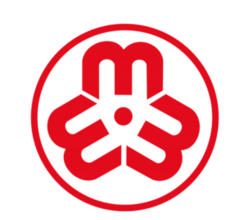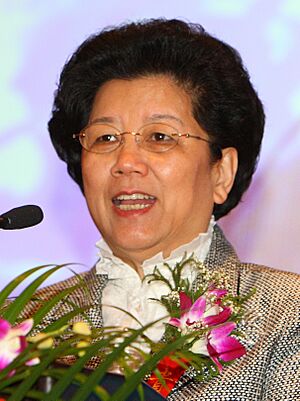All-China Women's Federation facts for kids
 |
|

Headquarters of the ACWF
|
|
| Abbreviation | ACWF |
|---|---|
| Formation | 24 March 1949 |
| Type | People's organization |
| Purpose | Women's rights |
| Headquarters | Beijing, People's Republic of China |
|
President
|
Shen Yiqin |
|
Vice President
|
Huang Xiaowei, etc |
|
Main organ
|
National Congress and Executive Committee |
| Affiliations | Communist Women's International (Historical) Women's International Democratic Federation (Historical) |
| All-China Women's Federation | |||||||||
|---|---|---|---|---|---|---|---|---|---|
| Simplified Chinese | 中华全国妇女联合会 | ||||||||
| Traditional Chinese | 中華全國婦女聯合會 | ||||||||
|
|||||||||
The All-China Women's Federation (ACWF) is a special group in China that works for women's rights. It was started on March 24, 1949. At first, it was called the All-China Democratic Women's Foundation. In 1957, its name changed to the All-China Women's Federation.
Since it began, the ACWF has been the main leader of the women's movement in China. Its job is to help the government make policies that support women. It also protects women's rights and helps them take part in society. The ACWF works to improve the lives of women across China.
History of Women's Rights in China
Early Efforts for Women's Equality
Before 1949, many people in China believed women were not as good as men. Early reformers wanted to change this idea. They felt women needed help to feel better about themselves. The Chinese Communist Party (CCP) showed interest in women's rights early on.
In 1922, the CCP said it wanted to end old Chinese traditions that held women back. They also promised equal rights and equal pay for men and women. This was a big step for women's equality.
Women's Groups and War Efforts
From 1924 to 1927, the CCP worked with another group, the Kuomintang (KMT). Both groups created their own women's departments. However, their partnership ended in 1927. The KMT then supported traditional ideas about women.
The CCP, however, continued to support women's freedom in areas they controlled. This time helped the CCP learn how to organize groups. This skill was very useful later when they formed the ACWF.
The Second Sino-Japanese War (1937–1945) brought new energy to the women's movement. Women leaders felt a strong desire to protect their country. They called for women to be free so they could help defend the nation. More women's groups formed within the CCP during the war.
In 1938, a meeting of women's leaders set goals for the movement. These goals included helping women escape bad marriages and improving their health. They also aimed to stop domestic abuse and protect women's right to inherit property. The ACWF later adopted many of these same goals.
ACWF's Start and Early Work (1949–1966)

The All-China Democratic Women's Federation started on March 24, 1949. It was the first women's group to cover all of China. It was renamed the All-China Women's Federation soon after. Important women leaders from the women's movement and the CCP joined its leadership.
Cai Chang, a key leader, became the first head of the ACWF. The group aimed to build a socialist China and improve women's lives. Over time, the ACWF also helped the CCP encourage women to join in economic and political activities.
Focus on Women's Issues and Family Life
In its early years, the ACWF focused on understanding women's problems. They did a lot of research on women's issues in China. This research helped them find solutions and propose new ideas.
The ACWF also encouraged women to understand their struggles from a class perspective. They helped women prepare to speak in public. This gave many women a voice for the first time.
In 1956, the "Five Good Family Campaign" started. It celebrated families for things like education, managing the home, and being good neighbors. The ACWF promoted this campaign to encourage women's contributions.
Around 1957, the ACWF became an official part of the government. It was now responsible for sharing government messages with women. It also helped organize events to get women involved in political campaigns. The ACWF helped China connect with women's groups in other countries too.
ACWF During the Cultural Revolution (1966–1976)
During the Cultural Revolution (1966–1976), many groups, including the ACWF, faced challenges. The women's movement was seen as old-fashioned. The ACWF closed down in 1968.
Many women leaders involved with the movement were sent to work in the countryside. The women's movement stopped working until 1976. After this period, the ACWF was fully restarted in 1978. It then supported plans to modernize China's agriculture, defense, industry, and technology.
ACWF in Modern Times (1976–Present)
After the Cultural Revolution, the ACWF focused more on protecting women's rights. It also worked to promote equality. The ACWF started to look at women's movements in other countries. They held discussions that went beyond what the CCP usually talked about.
The ACWF's campaigns became more varied. They tried to meet the different needs of women in cities and in the countryside. The ACWF still works with the government. However, it is no longer involved in big political campaigns.
New Focus and Independence
In the early 1990s, the government said the ACWF would watch how well the government was promoting women's rights. In 1992, the ACWF was allowed to start businesses. This made it less dependent on government money. It could then set its own goals more freely.
The ACWF started the "Four Self Campaign." This campaign encouraged women to have self-respect, self-confidence, self-improvement, and self-reliance. The ACWF also helped with the one-child policy. It told women about the policy. It also asked its leaders to follow the law and speak out against any forced actions related to the policy.
The ACWF also improved its legal training for leaders. It worked on gay rights, fought against job discrimination, and helped women who were trafficked. In 2000, the ACWF helped one million unemployed women find jobs. They created small businesses where women could work. The organization also helps women who are unmarried after age 27. It offers them chances to get an education instead of getting married.
By 1994, the ACWF had over 68,000 local groups. By 1995, the government called the ACWF a non-governmental organization (NGO). This was in response to comments from women's groups in other countries. By the late 1990s, there were thousands of women's groups under the ACWF.
In 2023, CCP general secretary Xi Jinping asked the ACWF to share good stories about family traditions. He also asked them to help create new ideas about marriage and having children.
How the ACWF Works
What the ACWF Does
The main work of the All-China Women's Federation is called funu gongzuo, or "women's work." The ACWF has seven main departments. These include departments for children, international connections, and women's development. There are also departments for publicity, women's rights, and human resources.
The ACWF works closely with the CCP. It has women's committees in the government. These committees deal with education, science, arts, and medicine. The government still has some control over the ACWF. This is through leaders who work for the federation and through promotions.
Groups Connected to the ACWF
The ACWF has many groups that help it reach more people. These include the China Women's Development Foundation and Marriage and Family Magazine. It also has the Legal Assistance Center, the China Women's University, and the China Women's News.
The ACWF also has a research center called the Women's Studies Institute of China (WSIC). Since 1990, this institute has done national surveys on women's status. The survey results help researchers understand women's lives.
The ACWF publishes over 49 newspapers and magazines. Important discussions about the women's movement happen in its national journals. These include Women of China and Chinese Women's Movements. The ACWF also runs programs for children whose parents work far away. These programs include summer camps and volunteer help.
ACWF's Structure and Party Links
The All-China Women's Federation says it is an NGO. However, it has a long history with the CCP. The ACWF has four levels, which match the government's system.
The highest group is the National Congress of Women. It meets every five years. This group looks at reports, sets goals for the women's movement, and elects leaders. Below this, provincial women's congresses meet every three years. Local groups must follow both ACWF and CCP rules. This structure helps the ACWF carry out party orders and share women's interests with the government.
Working with Local Communities
The ACWF is organized from the national level down to villages. However, the CCP has control at each level. The higher levels of the ACWF give advice and training to the lower levels. Some members feel that those trained by the CCP get promoted faster. This might make local members follow the party's wishes more than the ACWF's.
Other members believe that the local groups are very connected to the women they serve. They see little problem with the differences between the top and bottom levels.
ACWF and the Women's Movement
One challenge for the ACWF is that many women in China do not fully understand its work. ACWF members think this might be because the federation has many roles. Also, its way of representing women has not always been the same.
Challenges for the ACWF
Working with Other Women's Groups
The All-China Women's Federation is the biggest women's group in China. It is also the only one from before the 1980s that is still active. However, the ACWF has found it hard to represent all women's interests. Some people think that other groups should also help women.
Most women's NGOs in China work with the ACWF. They do this to gain trust and protection. Some new women's groups have more freedom to talk about sensitive topics. This is because they are not linked to the government. The ACWF has encouraged some of these groups. It has also brought others under its wing. This helps the ACWF reach more people.
Is the ACWF an NGO?
In 1995, the government officially called the All-China Women's Federation an NGO. But people disagree about whether it truly is an NGO. This is because of its long and ongoing connection with the CCP. Some women's movement leaders did not think the ACWF met the requirements of an NGO.
The ACWF itself is careful about using the term NGO inside China. This is because it has been linked to groups against the government. However, it uses the title when working with other countries. International groups that give money often prefer to work with NGOs. So, being called an NGO has helped the ACWF get funding from abroad.
Public Awareness of ACWF
Recently, fewer people in China know about the ACWF. This might be because of how the CCP government promotes its image. The government's influence can affect how people see the ACWF.
See also
- Government-organized non-governmental organization
- Women in China
- Feminism in China
- Gender equality
- March 8th Red Banner Pacesetter


